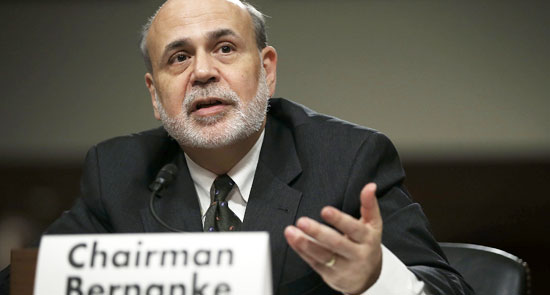
With one carefully briefed story, the US Federal Reserve overnight headed off a sharp and debilitating fall across US financial markets after a nasty slide spread from Japan, into the rest of Asia and Europe.
A story on The Wall Street Journal website in the well-known Real Time Economics blog left markets in no doubt that the Fed was not looking to bring forward any move to slow its current of easing or end it. It was written by Jon Hilsenrath, considered to be the US journalist closest to the Fed (his columns are jokingly called by some in the markets as “the Fed Wire”). That’s why the rebound this morning is now being called “The Hilsenrally”.
Such fears have driven US interest rates higher in the past month, and particularly since May 22 when Fed chairman Ben Bernanke used a form of words that raised doubt about the Fed’s timing and helped encourage speculation that the central bank might start cutting back on its $US85 billion month of easing spending sooner than later.
Allied with a shakeout in confidence in Japan about that central bank’s ability to manage its $US1.4 trillion reflation program, the pressure on interest rates increased, forcing the key US 10-year bond up 0.6% in a month. Japanese 10-year rates nudged 1% at one stage (which was a more than doubling) in the wake of the announcement of the huge spending program in early April.
That, in turn, caused the yen to start rising, the US dollar to fall, the Tokyo market to lose 22% of its value in a month or so, and markets across Asia and the emerging economies to tank. Australia wasn’t immune as fears about the strength of the Chinese economy meshed with these fears from the US and Japan.
And, with the Fed meeting for two days next week, fears grew that the central bank would announce a slowing in the spending (which amounts to a small tightening in monetary policy). Those fears proved too much, and we saw a very disorderly day or so of trading this week culminating with the slide across Asia.
And then The Wall Street Journal story appeared on the paper’s website around 3.40pm, New York time, and a weak rebound was turned into a 180-point advance on the down in minutes and the yield on 10-year bonds fell to 2.15% from close to 2.20% in early trading. That also casued the US dollar to slide, with the Aussie dollar jumping 2 US cents to close to 96.50 US cents as traders and our market was poised to jump by more than 1% this morning
So what did the story say? It suggested that at next week’s meeting, and in his press conference afterwards, the Fed and chairman Bernanke would make clear they were committed to keeping short-term interest rates low until the unemployment rate fell to a target of 6.5%.
The Fed has long made that point, but markets had begun to price in a shorter time horizon and focused on next week’s meeting, where such a decision would be made. In short, they had stopped listening to the Fed and Bernanke and gone charging off on their own, chanting “the sky is falling, the sky is falling'” It’s not, but never get between a rich banker or trader and the exit when it looks like the punchbowl is being taken away. So share and bond markets, especially in emerging and commodity based economies have tanked — naturally, that includes Australia.
That was reflected in the way interest rates in the US have risen strongly in the past month, especially on Treasuries and mortgages. As The Wall Street Journal story pointed out:
“A wide range of indicators suggest that investors are starting to think the Fed might start raising short-term interest rates — now near zero — sooner than previously thought. Until recently many market indicators suggested investors expected the first rate increases in mid-2015, but now these indicators indicate investors think it could be sooner. Since last December the Fed has been promising to keep short-term interest rates near zero until the jobless rate reaches 6.5%, as long as inflation doesn’t take off. Most forecasters don’t see the jobless rate reaching that threshold until mid-2015. At the same time, however, the Fed is talking about pulling back on its $85 billion-per-month bond-buying program. The chatter about pulling back the bond program has pushed up a wide range of interest rates and appears to have investors second-guessing the Fed’s broader commitment to keeping rates low. This is exactly what the Fed doesn’t want. Officials see bond buying as added fuel they are providing to a limp economy. Once the economy is strong enough to live without the added fuel, they still expect to keep rates low to ensure the economy keeps moving forward.”
That’s the point Bernanke is expected to emphasise next week.








Free money, thats what it is taking to keep this bubble going. The US ‘market’ is a criminal farce of gigantic proportions, never have so many been fleeced of so much by so few. I can’t wait for the denouement of the superannuation ‘investment’ con here in Oz, if the babyboomer repletes have any spine left they’ll dismember marcus padley et al.